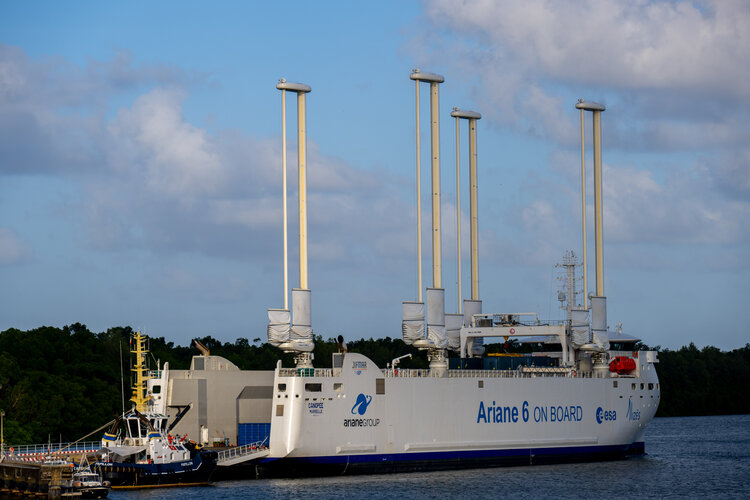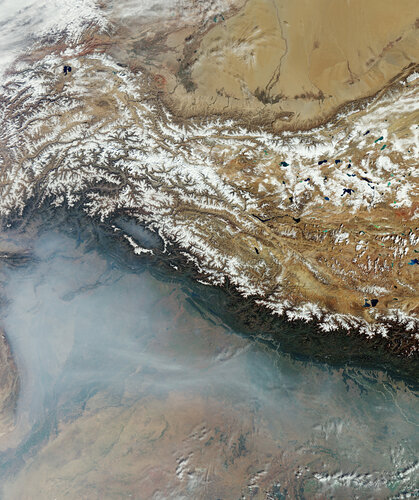MIT researchers remotely map crops, field by field
Friday, 23 February 2024 19:54 Crop maps help scientists and policymakers track global food supplies and estimate how they might shift with climate change and growing populations. But getting accurate maps of the types of crops that are grown from farm to farm often requires on-the-ground surveys that only a handful of countries have the resources to maintain.
Now, MIT engineers have developed a method to quickly and ac
Crop maps help scientists and policymakers track global food supplies and estimate how they might shift with climate change and growing populations. But getting accurate maps of the types of crops that are grown from farm to farm often requires on-the-ground surveys that only a handful of countries have the resources to maintain.
Now, MIT engineers have developed a method to quickly and ac Harnessing light with hemispherical shells
Friday, 23 February 2024 19:54 In a groundbreaking study from Abdullah Gul University in Turkiye, researchers have developed a novel hemispherical shell structure for organic photovoltaic cells, significantly enhancing their light absorption and angular coverage. Published in the SPIE Journal of Photonics for Energy, this innovation could mark a pivotal shift in the quest for more efficient and sustainable solar energy soluti
In a groundbreaking study from Abdullah Gul University in Turkiye, researchers have developed a novel hemispherical shell structure for organic photovoltaic cells, significantly enhancing their light absorption and angular coverage. Published in the SPIE Journal of Photonics for Energy, this innovation could mark a pivotal shift in the quest for more efficient and sustainable solar energy soluti Week in images: 19-23 February 2024
Friday, 23 February 2024 13:09
Week in images: 19-23 February 2024
Discover our week through the lens
ESA satellite returns to Earth – ERS-2 reentry
Friday, 23 February 2024 11:46 Video:
00:03:29
Video:
00:03:29
Mission complete. ESA’s second European Remote Sensing (ERS-2) satellite has reentered Earth’s atmosphere over the North Pacific Ocean. The satellite returned at 18:17 CET (17:17 UTC) between Alaska and Hawaii.
ERS-2 was launched almost 30 years ago, on 21 April 1995. Together with ERS-1, it provided invaluable long-term data on Earth’s land surfaces, ocean temperatures, ozone layer and polar ice extent that revolutionised our understanding of the Earth system.
ERS-2’s reentry was ‘natural’. ESA used the last of its fuel, emptied its batteries and lowered the satellite from its altitude of 785 km to 573 km. This reduced the
Earth from Space: A veil of haze and smoke
Friday, 23 February 2024 08:00 Image:
This Copernicus Sentinel-3 image from October 2023 captures the plains of northern India and Pakistan under a white veil of haze and smoke.
Image:
This Copernicus Sentinel-3 image from October 2023 captures the plains of northern India and Pakistan under a white veil of haze and smoke. US heads back to the Moon -- with a commercial spaceship
Thursday, 22 February 2024 19:37 One giant leap for the private sector?
A Houston-based company is set Thursday to attempt to land America's first spaceship on the Moon in more than 50 years, as part of a new fleet of NASA-funded commercial landers intended to pave the way for astronauts to return to Earth's celestial neighbor later this decade.
If all goes well, Intuitive Machines will guide its hexagon-shaped robot Od
One giant leap for the private sector?
A Houston-based company is set Thursday to attempt to land America's first spaceship on the Moon in more than 50 years, as part of a new fleet of NASA-funded commercial landers intended to pave the way for astronauts to return to Earth's celestial neighbor later this decade.
If all goes well, Intuitive Machines will guide its hexagon-shaped robot Od NASA Science Aboard Intuitive Machines Continues Journey to Moon
Thursday, 22 February 2024 19:37 In a collaboration between NASA and Intuitive Machines, a suite of six science instruments and technology demonstrations has embarked on a pivotal journey to the Moon. This mission, aboard the Intuitive Machines lander named Odysseus, represents a significant milestone in lunar exploration, propelled by the ambitions of NASA's Artemis campaign and its Commercial Lunar Payload Services initiative
In a collaboration between NASA and Intuitive Machines, a suite of six science instruments and technology demonstrations has embarked on a pivotal journey to the Moon. This mission, aboard the Intuitive Machines lander named Odysseus, represents a significant milestone in lunar exploration, propelled by the ambitions of NASA's Artemis campaign and its Commercial Lunar Payload Services initiative A brief history of famous Moon landings and failures
Thursday, 22 February 2024 19:37 A spaceship built by a company in Texas is poised for lunar touchdown on Thursday, returning America to the Moon after more than five decades in what promises to be a historic first for the private sector.
Here's a look back at notable attempts - both successful and unsuccessful - at landing on Earth's cosmic companion.
- First survivable landing -
The Soviet Union led the United
A spaceship built by a company in Texas is poised for lunar touchdown on Thursday, returning America to the Moon after more than five decades in what promises to be a historic first for the private sector.
Here's a look back at notable attempts - both successful and unsuccessful - at landing on Earth's cosmic companion.
- First survivable landing -
The Soviet Union led the United Rocket Lab Schedules Launch Date for 45th Electron Mission to Deploy Earth-Imaging Satellite for Synspective
Thursday, 22 February 2024 19:37 Rocket Lab USA, Inc. (Nasdaq: RKLB) has announced the upcoming launch window for its 45th Electron mission, a dedicated effort aimed at deploying an Earth-imaging satellite for Synspective, a leading Japanese satellite constellation operator. The mission, christened "Owl Night Long," is slated for a 14-day launch window commencing on March 10th NZDT (March 9th UTC), setting the stage from Rocket
Rocket Lab USA, Inc. (Nasdaq: RKLB) has announced the upcoming launch window for its 45th Electron mission, a dedicated effort aimed at deploying an Earth-imaging satellite for Synspective, a leading Japanese satellite constellation operator. The mission, christened "Owl Night Long," is slated for a 14-day launch window commencing on March 10th NZDT (March 9th UTC), setting the stage from Rocket STORIES of Space teams with Maritime Launch Services for a Nova Scotia launch
Thursday, 22 February 2024 19:37 In a groundbreaking collaboration, STORIES of Space, a visionary nonprofit dedicated to intertwining human narratives with the cosmos, has joined forces with Maritime Launch Services, the pioneering entity behind Canada's inaugural commercial spaceport, Spaceport Nova Scotia. This partnership heralds the upcoming STORIES Mission 03, slated for 2024, which aims to propel thousands of human storie
In a groundbreaking collaboration, STORIES of Space, a visionary nonprofit dedicated to intertwining human narratives with the cosmos, has joined forces with Maritime Launch Services, the pioneering entity behind Canada's inaugural commercial spaceport, Spaceport Nova Scotia. This partnership heralds the upcoming STORIES Mission 03, slated for 2024, which aims to propel thousands of human storie SpaceX launches Indonesian satellite into orbit
Thursday, 22 February 2024 19:37 A SpaceX's Falcon 9 rocket has successfully deployed the Merah Putih 2 satellite into orbit, marking a significant step forward in enhancing broadband Internet access across Indonesia. The event took place at 3:11 p.m. EST on Tuesday, underscoring SpaceX's ongoing contributions to global telecommunications connectivity.
This mission signifies the 17th flight for the Falcon 9 two-stage rock
A SpaceX's Falcon 9 rocket has successfully deployed the Merah Putih 2 satellite into orbit, marking a significant step forward in enhancing broadband Internet access across Indonesia. The event took place at 3:11 p.m. EST on Tuesday, underscoring SpaceX's ongoing contributions to global telecommunications connectivity.
This mission signifies the 17th flight for the Falcon 9 two-stage rock Space Perspective Unveils The Future Of Human Space Travel
Thursday, 22 February 2024 19:37 Space Perspective, a trailblazer in the burgeoning space tourism industry, has recently made headlines with its unveiling of the Spaceship Neptune, setting a new standard for human space travel. This innovative venture marks a significant milestone, not only as the third-ever commercial suborbital spacecraft but also as the seventh new human spacecraft developed in the past half-century. The Spa
Space Perspective, a trailblazer in the burgeoning space tourism industry, has recently made headlines with its unveiling of the Spaceship Neptune, setting a new standard for human space travel. This innovative venture marks a significant milestone, not only as the third-ever commercial suborbital spacecraft but also as the seventh new human spacecraft developed in the past half-century. The Spa ESA and PLD Space join forces to enhance small satellite launch flexibility
Thursday, 22 February 2024 19:37 In a significant stride towards expanding Europe's capabilities in the burgeoning small satellite launch market, the European Space Agency (ESA) and PLD Space have inked a deal to co-fund the development of a cutting-edge payload accommodation system. This collaboration is set to enhance the flexibility and competitiveness of satellite deployments, leveraging the advanced capabilities of PLD Spa
In a significant stride towards expanding Europe's capabilities in the burgeoning small satellite launch market, the European Space Agency (ESA) and PLD Space have inked a deal to co-fund the development of a cutting-edge payload accommodation system. This collaboration is set to enhance the flexibility and competitiveness of satellite deployments, leveraging the advanced capabilities of PLD Spa Spire Global Awarded euro 8.4M by the European Maritime Safety Agency for Provision of SAT-AIS Data Services
Thursday, 22 February 2024 19:37 Spire Global, Inc. (NYSE: SPIR), a leading provider of satellite data solutions, has been awarded two significant framework contracts by the European Maritime Safety Agency (EMSA), amounting to a maximum overall budget of euro 8.4 million. These contracts mark a continuation and expansion of Spire's collaboration with EMSA, building on a partnership that has provided crucial satellite automatic
Spire Global, Inc. (NYSE: SPIR), a leading provider of satellite data solutions, has been awarded two significant framework contracts by the European Maritime Safety Agency (EMSA), amounting to a maximum overall budget of euro 8.4 million. These contracts mark a continuation and expansion of Spire's collaboration with EMSA, building on a partnership that has provided crucial satellite automatic SatPlus Launch: emnify Leads with First-ever Cellular-Satellite IoT eSIM in US and Europe
Thursday, 22 February 2024 19:37 Emnify, a supplier of cloud-native IoT connectivity solutions, has officially launched the SuperNetwork SatPlus, marking the introduction of the first-ever converged cellular and satellite IoT connectivity available through a single emnify IoT eSIM. This groundbreaking offering is a part of the emnify SuperNetwork, a premier service in IoT cellular connectivity that boasts multi-network coverage
Emnify, a supplier of cloud-native IoT connectivity solutions, has officially launched the SuperNetwork SatPlus, marking the introduction of the first-ever converged cellular and satellite IoT connectivity available through a single emnify IoT eSIM. This groundbreaking offering is a part of the emnify SuperNetwork, a premier service in IoT cellular connectivity that boasts multi-network coverage 
